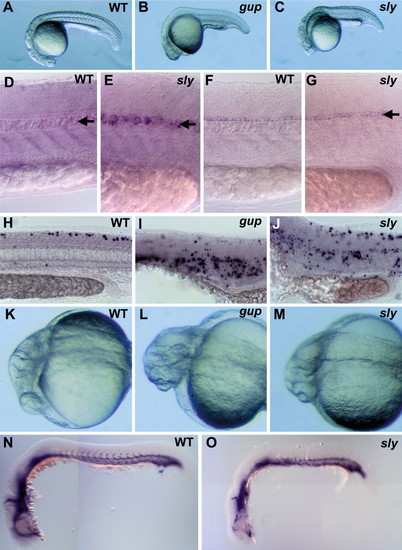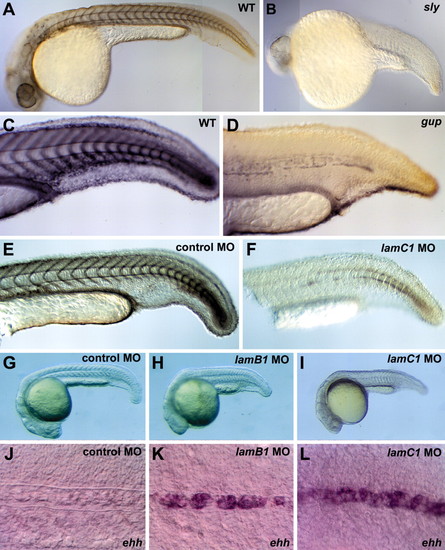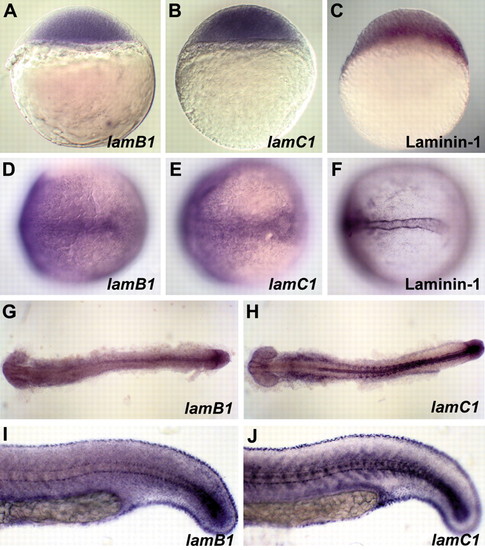- Title
-
Zebrafish mutants identify an essential role for laminins in notochord formation
- Authors
- Parsons, M.J., Pollard, S.M., Saude, L., Feldman, B., Coutinho, P., Hirst, E.M., and Stemple, D.L.
- Source
- Full text @ Development
|
Morphological and molecular analysis of sly and gup mutants. Lateral views show morphological phenotypes of wild-type (WT) (A), gup (B) and sly (C) mutant embryos at 22 hpf. (D) Whole-mount in situ hybridization shows that by 28 hpf ehh expression is no longer observed in the wild-type vacuolated notochord (arrow). (E) In sly mutants the notochord remains undifferentiated and expression of ehh is maintained (arrow). (F,G) In WT and sly mutants, the expression of twhh is identical and restricted to the floor plate (arrows). (H) TUNEL analysis at 28 hpf shows that apoptosis is restricted to the dorsal neural tube in WT embryos. (I,J) In both gup (I) and sly (J) mutant embryos, more extensive apoptosis is observed along the embryonic midline. (K-M) Close-up images of WT (K), gup (L) and sly (M) mutant embryos at 22 hpf show the small retina and protruding lens of the mutants. (N,O) Whole-mount in situ hybridization to detect expression of fli1, a marker of vascular progenitor cells, shows that the inter somitic vessels seen forming in 22 hpf WT embryos (N) fail to form in sly mutants (O). PHENOTYPE:
|
|
gup and sly are phenocopied by antisense morpholino oligonucleotides (MO). (A-D) Laminin 1 staining in 32 hpf (A) and 24 hpf (C) WT, and 32 hpf sly (B) and 24 hpf gup (D) mutant embryos. (E,F) Control MO (E) and sly/lamC1 MO (F) -injected embryos at 24 hpf stained with anti-laminin 1 antibody shows the loss of laminin 1 in sly/lamc1 morphants. (G-L) Embryos injected with gup/lamb1 MO (H,K) or sly/lamc1 MO (I,L) possess a shortened body axis, and show maintenance of ehh expression in undifferentiated notochords (K,L) when compared with control MO injected embryos (G,J). |
|
Expression of lamb1 and lamc1. (A,B) Maternal expression of lamb1 (A) and lamc1 (B) is seen in 1000-cell embryos. (C) Maternal laminin 1 protein is also detected. (D-F) Posterior views reveal expression of lamb1 (D) and lamc1 (E) and laminin 1 protein (F) in tailbud stage embryos. (G,H) Flat mounts show lamb1 (G) and lamc1 (H) mRNA expression pattern in 15-somite stage embryos. (I,J) Lateral views of trunk show lamb1 (I) and lamc1 (J) mRNA expression at 22 hpf. EXPRESSION / LABELING:
|
|
Shield transplants indicate the requirement for a notochordal source of laminin β1. Results of transplanting: (A) gup mutant shield (labelled with Rhodamine-dextran, red) into a wild-type (WT) embryo; (B) sly mutant shield (red) into a wild-type embryo; (C) wild-type shield (Red) into a gup mutant embryo; (D,E) wild-type shield (red) into a sly mutant embryo; (F) wild-type shield into gup mutant embryo, stained with anti-laminin 1 antibody; and (G) wild-type shield (red) into sly mutant embryo, stained with anti-laminin 1 antibody. (F,G) Laminin 1 staining (black) is present around wild-type notochord tissue (arrowheads), but absent around mutant undifferentiated notochord (arrows). In G, transplanted wild-type tissue is labelled with Biotin-dextran and revealed with Fast Red. |
|
Electron micrographs of wild-type, sly and gup mutant embryos. Sections through notochords of (A,E) a wild-type (WT) embryo at 28 hpf; (B,F) a gup mutant at 28 hpf; (C,G) a wild-type embryo at 32 hpf; (D,H) a sly mutant at 32 hpf. Notochordal sheath (between arrowheads) of WT (A,E) and gup (B,F) 28 hpf embryos are shown with intracellular space to the left and extracellular to the right. Wild-type basement membrane (E) appears as three distinct layers; closest to the cell membrane is a faint diffuse layer, which probably contains laminin, followed by a fibrous layer running parallel to the plane of section and finally an outermost fibrous layer running perpendicular to the plane of section, both of which are likely to be collagen rich. Conversely, in a gup mutant sibling (F), a thick disorganized layer is observed. Similarly, in the more mature notochordal sheath of a 32 hpf wild-type embryo (G), a well organized sheath is observed (between arrowheads). In a sly mutant sibling (H), however, the sheath is completely disorganized (between arrowheads). (G) An example of wild-type rough endoplasmic reticulum is shown (arrow). Scale bars: in A 5 μm for A-D; in E, 0.5 μm for E-H. |





